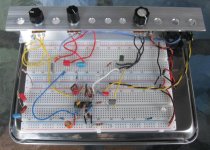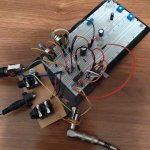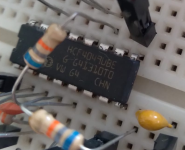Chuck D. Bones
Circuit Wizard
Moving on from the CMOS Raincoat, I fiddled the gain on all four stages, deleted the FAT switch and put the TONE control between the last two stages. This is more like a BMP, except the limiting comes from overdriving the CMOS inverters rather than clipping diodes. More dynamic and less bottom-end than a BMP. The CMOS inverters clip slightly asymmetrically, for some even-order harmonics. The large feedback resistors (R6 & R8) allow the two middle stages to run pretty much wide open. Note the bright cap on the SUSTAIN pot. The last stage provides just enough gain to recover the losses in the tone network without clipping. Responds well to the guitar's Volume knob. Fort a fatter tone, increase C3 & C5. This time around, I used a Motorola MC14049UBE.








